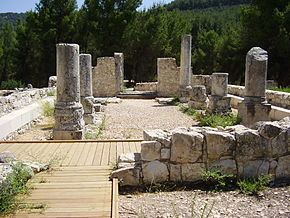Material Stone | ||
 | ||
Founded 2nd century-6th century Similar Nachal Adami, Har Hilel, Nachal Samach, Har Zevul, Nahal Sarach Reserve | ||
The Nabratein synagogue (Hebrew: נבוריה) is an ancient synagogue and archaeological site in the upper Galilee, in a pine forest northeast of Safed.
History
Naburiya was a Jewish village in the Galilee during the First and Second Temple periods. Neburaya is believed to be identical with Nabratein, a location north of Safed where Eleazar of Modi'im and Jacob of Kfar Neburaya, a compiler of the Haggadah, are buried. The excavated remains of the Naburiya synagogue indicate that it is one of the oldest in the Galilee. The original synagogue was enlarged during the third century and destroyed in the Galilee earthquake of 363.
The final, and much larger, synagogue building was constructed in the late 6th century reusing stones from the earlier building. The year of its construction is known from the inscription over the main door, now displayed at the Israel Museum: “Built four hundred and ninety four years after the destruction of the Temple under the leadership of Hanina ben Lizar and Luliana bar Yuden.” The building stood until 640 CE. The façade was partially reconstructed by the Jewish National Fund and the Israel Antiquities Authority.
The seven-branched Menorah surrounded by a wreath over the door of the Henry S. Frank Memorial Synagogue in Philadelphia, Pennsylvania is copied from the Nabratein synagogue.
